+ データを開く
データを開く
- 基本情報
基本情報
| 登録情報 | データベース: EMDB / ID: EMD-23922 | |||||||||
|---|---|---|---|---|---|---|---|---|---|---|
| タイトル | Cryo-EM structure of the c-MET II/HGF I complex bound with HGF II in a rigid conformation | |||||||||
 マップデータ マップデータ | Cryo-EM map of the c-MET II/HGF I complex bound with a HGF II in rigid conformation | |||||||||
 試料 試料 |
| |||||||||
 キーワード キーワード | c-MET / HGF / receptor tyrosine kinase / SIGNALING PROTEIN | |||||||||
| 機能・相同性 |  機能・相同性情報 機能・相同性情報regulation of p38MAPK cascade / skeletal muscle cell proliferation / negative regulation of guanyl-nucleotide exchange factor activity / hepatocyte growth factor receptor activity / regulation of branching involved in salivary gland morphogenesis by mesenchymal-epithelial signaling / Drug-mediated inhibition of MET activation / MET activates STAT3 / negative regulation of hydrogen peroxide-mediated programmed cell death / MET Receptor Activation / MET interacts with TNS proteins ...regulation of p38MAPK cascade / skeletal muscle cell proliferation / negative regulation of guanyl-nucleotide exchange factor activity / hepatocyte growth factor receptor activity / regulation of branching involved in salivary gland morphogenesis by mesenchymal-epithelial signaling / Drug-mediated inhibition of MET activation / MET activates STAT3 / negative regulation of hydrogen peroxide-mediated programmed cell death / MET Receptor Activation / MET interacts with TNS proteins / endothelial cell morphogenesis / hepatocyte growth factor receptor signaling pathway / semaphorin receptor activity / MET receptor recycling / pancreas development / MET activates PTPN11 / MET activates RAP1 and RAC1 / Sema4D mediated inhibition of cell attachment and migration / MET activates PI3K/AKT signaling / positive regulation of endothelial cell chemotaxis / negative regulation of stress fiber assembly / MET activates PTK2 signaling / positive regulation of DNA biosynthetic process / cellular response to hepatocyte growth factor stimulus / branching morphogenesis of an epithelial tube / positive chemotaxis / negative regulation of Rho protein signal transduction / negative regulation of release of cytochrome c from mitochondria / chemoattractant activity / negative regulation of thrombin-activated receptor signaling pathway / negative regulation of interleukin-6 production / semaphorin-plexin signaling pathway / myoblast proliferation / positive regulation of interleukin-10 production / epithelial to mesenchymal transition / establishment of skin barrier / positive regulation of osteoblast differentiation / MET activates RAS signaling / Regulation of MITF-M-dependent genes involved in cell cycle and proliferation / negative regulation of extrinsic apoptotic signaling pathway via death domain receptors / MECP2 regulates neuronal receptors and channels / positive regulation of microtubule polymerization / Interleukin-7 signaling / negative regulation of autophagy / cell surface receptor protein tyrosine kinase signaling pathway / basal plasma membrane / platelet alpha granule lumen / molecular function activator activity / InlB-mediated entry of Listeria monocytogenes into host cell / epithelial cell proliferation / cell chemotaxis / excitatory postsynaptic potential / growth factor activity / liver development / Negative regulation of MET activity / receptor protein-tyrosine kinase / negative regulation of inflammatory response / cell morphogenesis / neuron differentiation / Constitutive Signaling by Aberrant PI3K in Cancer / Platelet degranulation / PIP3 activates AKT signaling / mitotic cell cycle / PI5P, PP2A and IER3 Regulate PI3K/AKT Signaling / RAF/MAP kinase cascade / protein tyrosine kinase activity / Interleukin-4 and Interleukin-13 signaling / protein phosphatase binding / cell surface receptor signaling pathway / positive regulation of phosphatidylinositol 3-kinase/protein kinase B signal transduction / receptor complex / postsynapse / positive regulation of MAPK cascade / positive regulation of cell migration / signaling receptor binding / negative regulation of apoptotic process / cell surface / signal transduction / positive regulation of transcription by RNA polymerase II / extracellular space / extracellular region / ATP binding / identical protein binding / membrane / plasma membrane 類似検索 - 分子機能 | |||||||||
| 生物種 |  Homo sapiens (ヒト) Homo sapiens (ヒト) | |||||||||
| 手法 | 単粒子再構成法 / クライオ電子顕微鏡法 / 解像度: 4.9 Å | |||||||||
 データ登録者 データ登録者 | Uchikawa E / Chen ZM | |||||||||
 引用 引用 |  ジャーナル: Nat Commun / 年: 2021 ジャーナル: Nat Commun / 年: 2021タイトル: Structural basis of the activation of c-MET receptor. 著者: Emiko Uchikawa / Zhiming Chen / Guan-Yu Xiao / Xuewu Zhang / Xiao-Chen Bai /   要旨: The c-MET receptor is a receptor tyrosine kinase (RTK) that plays essential roles in normal cell development and motility. Aberrant activation of c-MET can lead to both tumors growth and metastatic ...The c-MET receptor is a receptor tyrosine kinase (RTK) that plays essential roles in normal cell development and motility. Aberrant activation of c-MET can lead to both tumors growth and metastatic progression of cancer cells. C-MET can be activated by either hepatocyte growth factor (HGF), or its natural isoform NK1. Here, we report the cryo-EM structures of c-MET/HGF and c-MET/NK1 complexes in the active state. The c-MET/HGF complex structure reveals that, by utilizing two distinct interfaces, one HGF molecule is sufficient to induce a specific dimerization mode of c-MET for receptor activation. The binding of heparin as well as a second HGF to the 2:1 c-MET:HGF complex further stabilize this active conformation. Distinct to HGF, NK1 forms a stable dimer, and bridges two c-METs in a symmetrical manner for activation. Collectively, our studies provide structural insights into the activation mechanisms of c-MET, and reveal how two isoforms of the same ligand use dramatically different mechanisms to activate the receptor. | |||||||||
| 履歴 |
|
- 構造の表示
構造の表示
| ムービー |
 ムービービューア ムービービューア |
|---|---|
| 構造ビューア | EMマップ:  SurfView SurfView Molmil Molmil Jmol/JSmol Jmol/JSmol |
| 添付画像 |
- ダウンロードとリンク
ダウンロードとリンク
-EMDBアーカイブ
| マップデータ |  emd_23922.map.gz emd_23922.map.gz | 69.9 MB |  EMDBマップデータ形式 EMDBマップデータ形式 | |
|---|---|---|---|---|
| ヘッダ (付随情報) |  emd-23922-v30.xml emd-23922-v30.xml emd-23922.xml emd-23922.xml | 13.5 KB 13.5 KB | 表示 表示 |  EMDBヘッダ EMDBヘッダ |
| 画像 |  emd_23922.png emd_23922.png | 163.4 KB | ||
| Filedesc metadata |  emd-23922.cif.gz emd-23922.cif.gz | 6.6 KB | ||
| アーカイブディレクトリ |  http://ftp.pdbj.org/pub/emdb/structures/EMD-23922 http://ftp.pdbj.org/pub/emdb/structures/EMD-23922 ftp://ftp.pdbj.org/pub/emdb/structures/EMD-23922 ftp://ftp.pdbj.org/pub/emdb/structures/EMD-23922 | HTTPS FTP |
-検証レポート
| 文書・要旨 |  emd_23922_validation.pdf.gz emd_23922_validation.pdf.gz | 557.9 KB | 表示 |  EMDB検証レポート EMDB検証レポート |
|---|---|---|---|---|
| 文書・詳細版 |  emd_23922_full_validation.pdf.gz emd_23922_full_validation.pdf.gz | 557.4 KB | 表示 | |
| XML形式データ |  emd_23922_validation.xml.gz emd_23922_validation.xml.gz | 6 KB | 表示 | |
| CIF形式データ |  emd_23922_validation.cif.gz emd_23922_validation.cif.gz | 6.9 KB | 表示 | |
| アーカイブディレクトリ |  https://ftp.pdbj.org/pub/emdb/validation_reports/EMD-23922 https://ftp.pdbj.org/pub/emdb/validation_reports/EMD-23922 ftp://ftp.pdbj.org/pub/emdb/validation_reports/EMD-23922 ftp://ftp.pdbj.org/pub/emdb/validation_reports/EMD-23922 | HTTPS FTP |
-関連構造データ
- リンク
リンク
| EMDBのページ |  EMDB (EBI/PDBe) / EMDB (EBI/PDBe) /  EMDataResource EMDataResource |
|---|---|
| 「今月の分子」の関連する項目 |
- マップ
マップ
| ファイル |  ダウンロード / ファイル: emd_23922.map.gz / 形式: CCP4 / 大きさ: 75.1 MB / タイプ: IMAGE STORED AS FLOATING POINT NUMBER (4 BYTES) ダウンロード / ファイル: emd_23922.map.gz / 形式: CCP4 / 大きさ: 75.1 MB / タイプ: IMAGE STORED AS FLOATING POINT NUMBER (4 BYTES) | ||||||||||||||||||||||||||||||||||||||||||||||||||||||||||||||||||||
|---|---|---|---|---|---|---|---|---|---|---|---|---|---|---|---|---|---|---|---|---|---|---|---|---|---|---|---|---|---|---|---|---|---|---|---|---|---|---|---|---|---|---|---|---|---|---|---|---|---|---|---|---|---|---|---|---|---|---|---|---|---|---|---|---|---|---|---|---|---|
| 注釈 | Cryo-EM map of the c-MET II/HGF I complex bound with a HGF II in rigid conformation | ||||||||||||||||||||||||||||||||||||||||||||||||||||||||||||||||||||
| 投影像・断面図 | 画像のコントロール
画像は Spider により作成 | ||||||||||||||||||||||||||||||||||||||||||||||||||||||||||||||||||||
| ボクセルのサイズ | X=Y=Z: 1.08 Å | ||||||||||||||||||||||||||||||||||||||||||||||||||||||||||||||||||||
| 密度 |
| ||||||||||||||||||||||||||||||||||||||||||||||||||||||||||||||||||||
| 対称性 | 空間群: 1 | ||||||||||||||||||||||||||||||||||||||||||||||||||||||||||||||||||||
| 詳細 | EMDB XML:
CCP4マップ ヘッダ情報:
| ||||||||||||||||||||||||||||||||||||||||||||||||||||||||||||||||||||
-添付データ
- 試料の構成要素
試料の構成要素
-全体 : The c-MET II/HGF I complex bound with HGF II in a rigid conformation
| 全体 | 名称: The c-MET II/HGF I complex bound with HGF II in a rigid conformation |
|---|---|
| 要素 |
|
-超分子 #1: The c-MET II/HGF I complex bound with HGF II in a rigid conformation
| 超分子 | 名称: The c-MET II/HGF I complex bound with HGF II in a rigid conformation タイプ: complex / ID: 1 / 親要素: 0 / 含まれる分子: all |
|---|---|
| 由来(天然) | 生物種:  Homo sapiens (ヒト) Homo sapiens (ヒト) |
-分子 #1: Hepatocyte growth factor
| 分子 | 名称: Hepatocyte growth factor / タイプ: protein_or_peptide / ID: 1 / コピー数: 2 / 光学異性体: LEVO |
|---|---|
| 由来(天然) | 生物種:  Homo sapiens (ヒト) Homo sapiens (ヒト) |
| 分子量 | 理論値: 83.249828 KDa |
| 組換発現 | 生物種:  Homo sapiens (ヒト) Homo sapiens (ヒト) |
| 配列 | 文字列: MWVTKLLPAL LLQHVLLHLL LLPIAIPYAE GQRKRRNTIH EFKKSAKTTL IKIDPALKIK TKKVNTADQC ANRCTRNKGL PFTCKAFVF DKARKQCLWF PFNSMSSGVK KEFGHEFDLY ENKDYIRNCI IGKGRSYKGT VSITKSGIKC QPWSSMIPHE H SFLPSSYR ...文字列: MWVTKLLPAL LLQHVLLHLL LLPIAIPYAE GQRKRRNTIH EFKKSAKTTL IKIDPALKIK TKKVNTADQC ANRCTRNKGL PFTCKAFVF DKARKQCLWF PFNSMSSGVK KEFGHEFDLY ENKDYIRNCI IGKGRSYKGT VSITKSGIKC QPWSSMIPHE H SFLPSSYR GKDLQENYCR NPRGEEGGPW CFTSNPEVRY EVCDIPQCSE VECMTCNGES YRGLMDHTES GKICQRWDHQ TP HRHKFLP ERYPDKGFDD NYCRNPDGQP RPWCYTLDPH TRWEYCAIKT CADNTMNDTD VPLETTECIQ GQGEGYRGTV NTI WNGIPC QRWDSQYPHE HDMTPENFKC KDLRENYCRN PDGSESPWCF TTDPNIRVGY CSQIPNCDMS HGQDCYRGNG KNYM GNLSQ TRSGLTCSMW DKNMEDLHRH IFWEPDASKL NENYCRNPDD DAHGPWCYTG NPLIPWDYCP ISRCEGDTTP TIVNL DHPV ISCAKTKQLR VVNGIPTRTN IGWMVSLRYR NKHICGGSLI KESWVLTARQ CFPSRDLKDY EAWLGIHDVH GRGDEK CKQ VLNVSQLVYG PEGSDLVLMK LARPAVLDDF VSTIDLPNYG CTIPEKTSCS VYGWGYTGLI NYDGLLRVAH LYIMGNE KC SQHHRGKVTL NESEICAGAE KIGSGPCEGD YGGPLVCEQH KMRMVLGVIV PGRGCAIPNR PGIFVRVAYY AKWIHKII L TYKVPQS UniProtKB: Hepatocyte growth factor |
-分子 #2: Hepatocyte growth factor receptor
| 分子 | 名称: Hepatocyte growth factor receptor / タイプ: protein_or_peptide / ID: 2 / コピー数: 1 / 光学異性体: LEVO / EC番号: receptor protein-tyrosine kinase |
|---|---|
| 由来(天然) | 生物種:  Homo sapiens (ヒト) Homo sapiens (ヒト) |
| 分子量 | 理論値: 155.720625 KDa |
| 組換発現 | 生物種:  Homo sapiens (ヒト) Homo sapiens (ヒト) |
| 配列 | 文字列: MKAPAVLAPG ILVLLFTLVQ RSNGECKEAL AKSEMNVNMK YQLPNFTAET PIQNVILHEH HIFLGATNYI YVLNEEDLQK VAEYKTGPV LEHPDCFPCQ DCSSKANLSG GVWKDNINMA LVVDTYYDDQ LISCGSVNRG TCQRHVFPHN HTADIQSEVH C IFSPQIEE ...文字列: MKAPAVLAPG ILVLLFTLVQ RSNGECKEAL AKSEMNVNMK YQLPNFTAET PIQNVILHEH HIFLGATNYI YVLNEEDLQK VAEYKTGPV LEHPDCFPCQ DCSSKANLSG GVWKDNINMA LVVDTYYDDQ LISCGSVNRG TCQRHVFPHN HTADIQSEVH C IFSPQIEE PSQCPDCVVS ALGAKVLSSV KDRFINFFVG NTINSSYFPD HPLHSISVRR LKETKDGFMF LTDQSYIDVL PE FRDSYPI KYVHAFESNN FIYFLTVQRE TLDAQTFHTR IIRFCSINSG LHSYMEMPLE CILTEKRKKR STKKEVFNIL QAA YVSKPG AQLARQIGAS LNDDILFGVF AQSKPDSAEP MDRSAMCAFP IKYVNDFFNK IVNKNNVRCL QHFYGPNHEH CFNR TLLRN SSGCEARRDE YRTEFTTALQ RVDLFMGQFS EVLLTSISTF IKGDLTIANL GTSEGRFMQV VVSRSGPSTP HVNFL LDSH PVSPEVIVEH TLNQNGYTLV ITGKKITKIP LNGLGCRHFQ SCSQCLSAPP FVQCGWCHDK CVRSEECLSG TWTQQI CLP AIYKVFPNSA PLEGGTRLTI CGWDFGFRRN NKFDLKKTRV LLGNESCTLT LSESTMNTLK CTVGPAMNKH FNMSIII SN GHGTTQYSTF SYVDPVITSI SPKYGPMAGG TLLTLTGNYL NSGNSRHISI GGKTCTLKSV SNSILECYTP AQTISTEF A VKLKIDLANR ETSIFSYRED PIVYEIHPTK SFISGGSTIT GVGKNLNSVS VPRMVINVHE AGRNFTVACQ HRSNSEIIC CTTPSLQQLN LQLPLKTKAF FMLDGILSKY FDLIYVHNPV FKPFEKPVMI SMGNENVLEI KGNDIDPEAV KGEVLKVGNK SCENIHLHS EAVLCTVPND LLKLNSELNI EWKQAISSTV LGKVIVQPDQ NFTGLIAGVV SISTALLLLL GFFLWLKKRK Q IKDLGSEL VRYDARVHTP HLDRLVSARS VSPTTEMVSN ESVDYRATFP EDQFPNSSQN GSCRQVQYPL TDMSPILTSG DS DISSPLL QNTVHIDLSA LNPELVQAVQ HVVIGPSSLI VHFNEVIGRG HFGCVYHGTL LDNDGKKIHC AVKSLNRITD IGE VSQFLT EGIIMKDFSH PNVLSLLGIC LRSEGSPLVV LPYMKHGDLR NFIRNETHNP TVKDLIGFGL QVAKGMKYLA SKKF VHRDL AARNCMLDEK FTVKVADFGL ARDMYDKEYY SVHNKTGAKL PVKWMALESL QTQKFTTKSD VWSFGVLLWE LMTRG APPY PDVNTFDITV YLLQGRRLLQ PEYCPDPLYE VMLKCWHPKA EMRPSFSELV SRISAIFSTF IGEHYVHVNA TYVNVK CVA PYPSLLSSED NADDEVDTRP ASFWETS UniProtKB: Hepatocyte growth factor receptor |
-実験情報
-構造解析
| 手法 | クライオ電子顕微鏡法 |
|---|---|
 解析 解析 | 単粒子再構成法 |
| 試料の集合状態 | particle |
- 試料調製
試料調製
| 緩衝液 | pH: 7.5 |
|---|---|
| 凍結 | 凍結剤: ETHANE |
- 電子顕微鏡法
電子顕微鏡法
| 顕微鏡 | FEI TITAN KRIOS |
|---|---|
| 撮影 | フィルム・検出器のモデル: GATAN K3 BIOQUANTUM (6k x 4k) 平均電子線量: 60.0 e/Å2 |
| 電子線 | 加速電圧: 300 kV / 電子線源:  FIELD EMISSION GUN FIELD EMISSION GUN |
| 電子光学系 | 照射モード: FLOOD BEAM / 撮影モード: BRIGHT FIELD |
| 試料ステージ | 試料ホルダーモデル: FEI TITAN KRIOS AUTOGRID HOLDER ホルダー冷却材: NITROGEN |
| 実験機器 |  モデル: Titan Krios / 画像提供: FEI Company |
 ムービー
ムービー コントローラー
コントローラー














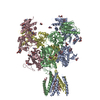
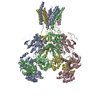
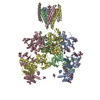
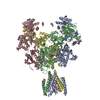

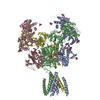

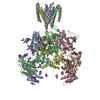
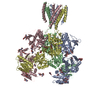













 Z (Sec.)
Z (Sec.) Y (Row.)
Y (Row.) X (Col.)
X (Col.)





















